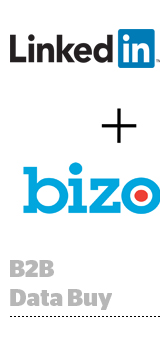 LinkedIn will buy Bizo, a B2B display ad platform, for $175 million in cash and stock, the companies said Tuesday.
LinkedIn will buy Bizo, a B2B display ad platform, for $175 million in cash and stock, the companies said Tuesday.
“It’s exciting for us to bring Bizo’s expertise and technology into our ecosystem,” said Deep Nishar, LinkedIn’s SVP of product and user experience, in a statement. “Our ability to integrate their B2B solutions with our content marketing products will enable us to become the most effective platform for B2B marketers to engage professionals.”
The acquisition will be funded through a combination of cash (90%) and LinkedIn stock (10%) and is expected to close in the third quarter of 2014.
Read LinkedIn’s blog post and the press release.
LinkedIn is ramping up its marketing solutions. It hired longtime ad exec Penry Price as VP of marketing solutions, and recently outlined methods to monetize content with a premium business audience on its platform.
Bizo’s acquisition should also come as no surprise. Founded in 2008 as a platform to enable B2B marketers to track and reach new business users, it’s easy to see what made the company an attractive target this year. In Q4, Bizo cited revenue of $12.4 million at a $50 million run rate with media costs that average in the 35-40% range.
The company has also released numerous products and enhancements. Last fall, it launched Bizo for Marketing Automation, a product with a “multimillion dollar” trajectory, according to Bizo’s CEO Russ Glass. Months later, Bizo released Multichannel Nurturing, a tool that promised marketers greater lead-gen capabilities across email, display and social advertising.
One of the limitations of standard marketing automation system (MAS), Glass said in a recent interview, is that device fragmentation complicates the path to purchase. Systems focusing on a single channel or marketing database overlook a lot of behavioral and intent data.
Partnerships like last year’s, between Oracle Eloqua and Bizo, were intended to mitigate that challenge.
As Bizo pointed out at the time, “For B2B websites, 95% of their website traffic still remains anonymous. … What if we can hook up display advertising to the marketing automation system and allow Eloqua users to track digital body language and [retarget] visitors who are looking at certain products?” Both the MAS system and targeting mechanism become synergistically strengthened.
LinkedIn and Bizo have a longstanding relationship, which has resulted in a LinkedIn Ads API partnership. LinkedIn also partners with Oracle-owned BlueKai for data management and to analyze first-party data sets through BlueKai while Bizo powers the Oracle Eloqua AdFocus application. It makes sense for the Oracle-BlueKai-LinkedIn equation to include Bizo.
LinkedIn recognizes its position and user saturation (300 million strong) in the B2B marketing space, but realizes the potential to scale its off-network capabilities and ultimately improve B2B addressability.
At present, auction-based sponsored updates account for 19% of marketing Solutions revenue with more than 3,500 active daily customers. LinkedIn is drumming up content marketing efforts, but appears to realize the value of programmatic ad targeting and catching user intent off LinkedIn to improve its own advertiser experience, such as what Facebook and Twitter have done with custom and tailored audiences, respectively.
Here’s where LinkedIn grabs a serious business media data play: Bizo, beyond its marketing automation tool set, runs a viable media business and partners with a number of large ad networks, DSPs and trading desks, as well as the Google and Adobe stacks, to identify and enrich business data targets through its pixel-based network. Additionally, a number of Bizo’s publisher clients rely on Bizo data to target their own media.
This essentially gives LinkedIn the basis of an end-to-end platform to identify in-market prospects, research and track those leads through to the buying process and ultimately close that loop with analytics.















